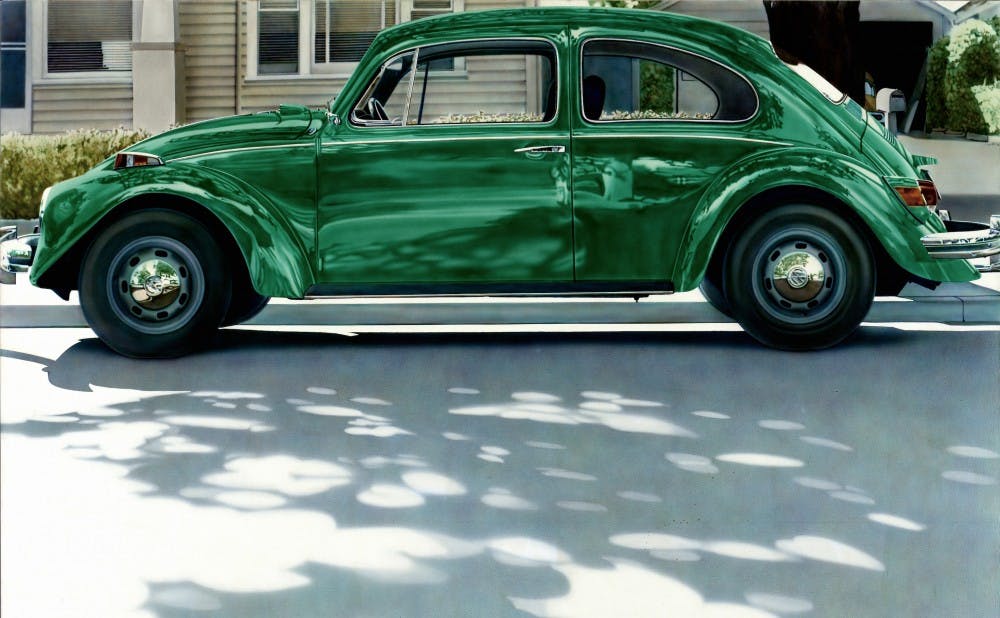As the hustle and bustle of the new academic year settled in and Duke welcomed its new students, the Nasher Museum of Art, too, welcomed a new collection of paintings, with “Disorderly Conduct: American Painting and Sculpture, 1960-1990.”
Disorderly Conduct is on display from Sept. 21, 2017 to Feb. 25, 2018 at the Nasher Museum of Art at Duke University. The opening party was held on Thursday, Sept. 21, 2017 where the museum invited guests to join Curator Marshall Price in celebrating the opening of the exhibition. The party was punctuated by a playlist of music from the era with an emphasis on the 1980s. The collection can be viewed at the Wilson Pavilion of the Nasher, which is primarily dedicated to historic areas of the museum’s collection.
Including a view of the cathedral at Siena, a vintage and luminous green car in the streets on a sunny afternoon and an untitled abstract painting, the paintings and sculptures at the exhibition may look very different, but they are bonded by a common theme of the varied artistic approaches that developed during the decade immediately following World War II.
Some of the prominent themes of the exhibition include minimalism, neo-expressionism and photorealism, which uses a hyper-real technique to meticulously render scenes of everyday life.
“There are three primary threads of the installation,” Price said. “One is Abstraction, the other is representation or figurative work and the third is artists dealing with issues of identity in the ‘70s and ‘80s.”
Putting up “Disorderly Conduct” was more of a continuous process rather than a project under a strict time frame. However, the curators did work on and off for about a year to present the exhibition.
“Sometimes it takes a long time for these things to ferment in my mind, ” Price said. He wanted to title the exhibition in such a way that made it immediately evident how chaotic this period of art was. “Art historians love when things are neat and organized, but history doesn’t really work that way.”
The “Untitled” painting by Al Held was one piece of the exhibit that Price talked about in most detail. He said that it was a recent acquisition and a very important transitional work for the artists but also illustrative of the changing American aesthetics of the late 1950s. The piece by Robert Kushner was also eminent because of its critical challenge to modernism — Kushner was part of a movement that was challenging the male-dominated orthodoxy of modernism that had reigned centrally unchallenged until the late 1960s.
Browsing the gallery, one can see an array of vibrant colors used to depict everyday scenes through the themes of minimalism, photorealism and neo-expressionism. These themes are not only expressed through the medium of painting but also through carefully curated sculptures.
“The sculpture is a pretty eclectic mix of things representing a struggle between abstraction and figuration,” Price said of these alternative mediums of expression.
In addition, the museum’s Alzheimer’s program “Reflections” provides engaging and interactive museum tours to visitors with Alzheimer’s disease and related dementia, their families, and their care partners.The Nasher is offering a Reflections tour of “Disorderly Conduct” Tuesday, Oct. 24, 2017, followed by a musical performance that complements the exhibition.
The museum invites ardent art critiques to savor the exhibition at a slower pace by joining gallery guide Maggie Griffin for a deeper look at a single work of art from the museum’s collection in Disorderly Conduct. Held on Saturday, Oct. 14, 2017, this event is free with general admission.
In the words of Price, “Disorderly Conduct” navigates a “meandering journey through three decades of American painting and sculpture.” At the moment, Wilson Pavilion showcases myriad concepts of art that represent an extraordinary section of history presented through ordinary visions.
Get The Chronicle straight to your inbox
Sign up for our weekly newsletter. Cancel at any time.

